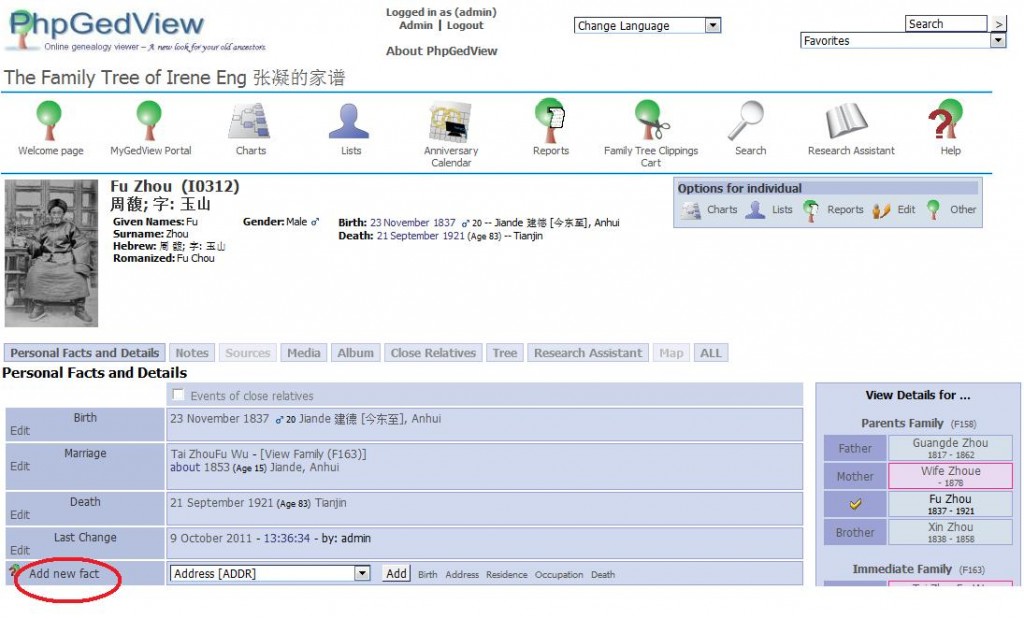Add new fact
Posted: October 18, 2011 Filed under: PGV Docs 文件, Screenshots 图解 Leave a comment »At the bottom left is where you can add a fact to the personal record being edited.
First choose a fact from the drop-down list, then click the Add button. All possible facts that you can add to the database are in that drop-down list.
ADD CUSTOM FACT
If you can’t find the fact that you want to add in the list of GEDCOM facts, you can enter a custom fact as well.
Entering a custom fact is just as simple as entering one of the pre-defined ones. The only difference is that you have to name the fact instead of picking its name from a list. You have to do this in the top field: Type
ADD FROM CLIPBOARD
PhpGedView allows you to copy up to 10 facts, with all their details, to a clipboard. This clipboard is different from the Clippings Cart that you can use to export portions of your database.
You can select any of the facts from the clipboard and copy the selected fact to the Individual, Family, Media, Source, or Repository record currently being edited. However, you cannot copy facts of dissimilar record types. For example, you cannot copy a Marriage fact to a Source or an Individual record since the Marriage fact is associated only with Family records.
This is very helpful when entering similar facts, such as census facts, for many individuals or families.
DATES IN A GEDCOM FILE
Although the date field allows for free-form entry (meaning you can type in whatever you want), there are some rules about how dates should be entered according to the GEDCOM 5.5.1 standard.
- A full date is entered in the form DD MMM YYYY. For example, 01 MAR 1801 or 14 DEC 1950.
- If you are missing a part of the date, you can omit that part. E.g. MAR 1801 or 14 DEC.
- If you are not sure or the date is not confirmed, you could enter ABT MAR 1801 (abt = about), BEF 20 DEC 1950 (bef = before), AFT 1949 (aft = after)
- Date ranges are entered as FROM MAR 1801 TO 20 DEC 1810 or as BET MAR 1801 AND 20 DEC 1810(bet = between)The FROM form indicates that the event being described happened continuously between the stated dates and is used with events such as employment. The BET form indicates a single occurrence of the event, sometime between the stated dates and is used with events such as birth.
Imprecise dates, where the day of the month or the month is missing, are always interpreted as the first or last possible date, depending on whether that imprecise date occurs before or after the separating keyword. For example, FEB 1804 is interpreted as 01 FEB 1804 when it occurs before the TO or AND, and as 29 FEB 1804 when it occurs after the TO or AND.
Be sure to enter dates and abbreviations in English, because then the GEDCOM file is exchangeable and PhpGedView can translate all dates and abbreviations properly into the currently active language. Furthermore, PhpGedView does calculations using these dates. If improper dates are entered into date fields, PhpGedView will not be able to calculate properly.
You can click on the Calendar icon for help selecting a date.
GENERAL INFO ABOUT ADDING
When you have added a fact, note, source, or multimedia file to a record in the database, the addition still has to be approved by a user who has Accept rights.
Until the changes have been Accepted, they are identified as “pending” by a differently colored border. All users with Edit rights can see these changes as well as the original information. Users who do not have Edit rights will only see the original information. When the addition has been Accepted, the borders will disappear and the new data will display normally, replacing the old. At that time, users without Edit rights will see the new data too.

Recent Comments